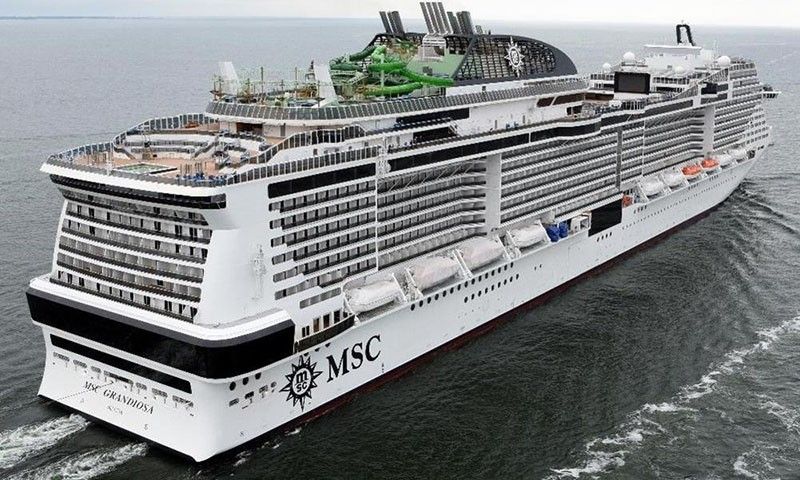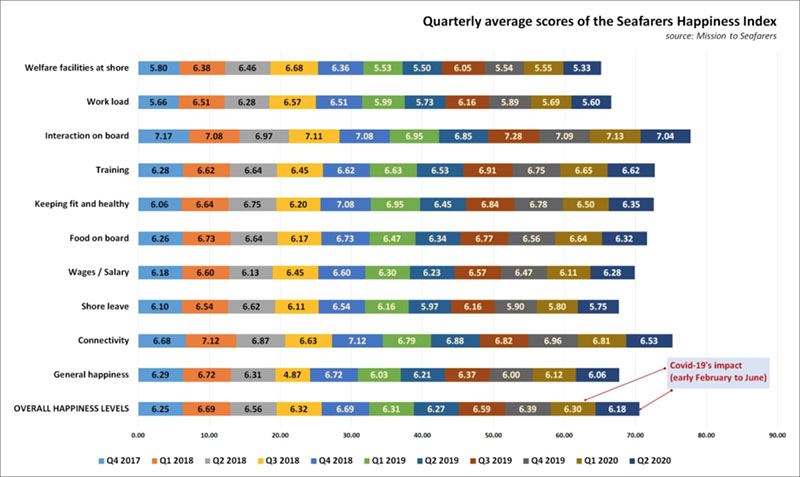As some ships sail again, survey says seafarers facing ‘mental health crisis’

ADELAIDE, AUSTRALIA — The horns sounded off in Genoa, Italy when the cruise line MSC Grandiosa left that city’s port August 16 to resume operations even during the COVID-19 pandemic.
A Filipina crew member even captured the moment on her mobile phone, then she said “Thank you!” On the background, male Filipino seafarers were happily howling (“Wala pang pagkain!” [There’s no food yet!]) and whistling. Bells even rung that Sunday at the port.
Those noises of joy relieved months of tensions that the world’s seafarers, a quarter of which are Filipinos, endured given how COVID-19 threatened them from infection and mental agony. Shipping companies now keep watch at how cruise ships like MSC Grandiosa and a few others test the waters of operating beside the planet’s deadliest public health threat.
However, the emotional impacts of COVID-19 scream of a “mental health crisis” that the pandemic continues to sweep over the world’s 1.67 million merchant marine fleet, says new results of a quarterly happiness survey for seafarers.
Seafarers’ levels of happiness declined because of heavy workloads, the disallowing of crew changes in many ports, increased sickness, and pressure to follow hygiene regulations to elude the contraction of SARS-Cov-2, the latest quarterly Seafarers Happiness Index (SHI) showed.
Administered by British-run Christian charity Mission to Seafarers, overall happiness levels of seafarers during the second quarter of 2020 (May to June) reached their lowest average score —6.18 out of 10— since MtS started the Index in the fourth quarter of 2017.
(The highest overall happiness levels recorded as 6.69, which happened twice.)
These results come at the heels of five full months that a COVID-19 pandemic has swept many cruise ships, oil tankers and container vessels. These ships have visible numbers of Filipino crew.
“The seafarer community is in the midst of a mental health crisis,” MtS’s second quarter 2020 SHI report wrote.
The SHI is a result of a ten-question online survey that seafarers are encouraged to accomplish. Each question is a Likert scale that asks seafarers to rate their levels of happiness on: welfare facilities at shore, workload, interaction on board, training, health and fitness, food being served, wages, shore leave, connectivity and general happiness.
‘Crisis’
Pre-pandemic mental health concerns “are no less serious” but seafarers’ mental well-being beside COVID-19 is different, SHI founder Steven Jones told The Filipino Connection.
“(Previous mental health crises seafarers faced) do not have the added COVID-19 element of seafarer concern for families at home,” Jones emailed.
“The word ‘crisis’ is, granted, subjective. However, given the rising rhetoric on all sides, it would seem wrong not to escalate (the situation) in stride with others,” the maritime consultant adds.
Not only is the “overall happiness level” of respondent-seafarers at its historic lowest mean score in this quarterly survey. Four of the ten question items were at their historic lowest levels too: welfare facilities at shore (5.33), work load (5.60), shore leave (5.75), and connectivity (6.53).
Comparing SHI results this quarter with the first quarter of 2020), nine of ten question items got lower average scores —except for wages or salary (6.11 during the first quarter, and 6.28 in this quarter).

“We see that seafarers are not just unhappy with single isolated issues. They are feeling dissatisfied across the board,” MtS wrote.
“It seems clear that seafarers are suffering,” Jones said. “They are not happy, and it is not hard to see why.”
Re-echoing the key messages of the SHI’s latest results, Jones said seafarers “are having to serve hugely extended trips” without any assurance of when they will sail or fly back to their mother countries given seaport closures and airport restrictions on travel.
Seafarers also get many “demands on their time on board, with (hygiene) regimes being so strictly enforced” and social distancing affecting their lives and interactions with fellow crew and passengers (the latter for cruise ships).
‘Crew change crisis’
Not only did the MtS warn of a mental health crisis. There’s also a “crew change crisis.”
The crew change crisis has reached a point in which seafarers “are running out of patience… and want to be home,” the latest SHI report wrote.
Seafarers’ happiness and satisfaction will “climb once more” should they get reunited with their families. But until the wide seaport closures remain and only a few international seaports, like Manila, allow crew changes, “it is hard to anticipate how the mood (of seafarers) can be lightened up and spirits raised,” MtS wrote.
Majority of SHI’s latest respondents work in tankers (34%); are between 25-34 years old (64%); are second and third officers (18% and 15%, respectively); and are male (92%).
Respondents working for cruise ships only make up 4% of respondents. It is cruise ships that have hogged global headlines as major clusters of COVID-19 outbreaks, citing the cases of the Diamond Princess (Japan) and the Ruby Princess (Australia).
The world has an estimated 1.647 million seafarers, shipping industry reports show.
Counseling
Seafarers’ charities like MtS and the International Seafarers Welfare Action Network (ISWAN) have circulated online booklets on seafarers’ psychological well-being. These efforts make up for the limited number of maritime psychologists worldwide.
ISWAN also runs SeafarerHelp, a free, multilingual and confidential counseling service (via voice over internet protocol means or VoIP) for seafarers and their families. Given the pandemic, ISWAN reports the running count of counseling cases through SeafarerHelp has exceeded the 3,260 cases (involving 8,111 seafarers and their families) combining the years 2018 and 2019.
Filipinos are the most assisted nationality of the SeafarerHelp service (26% of all cases), ISWAN’s 2018-2019 Annual Report bared.
Crew from the Philippines
China and the Philippines are the world’s two top supplying countries of merchant marine fleet, a 2015 industry survey report on shipping manpower bared.
The Chinese are said to be most the number of officers; Filipinos top among the suppliers of ratings crew.
The Philippines has around 449,463 seafarers as of 2018 deployment data from the Philippine Overseas Employment Administration (POEA).
Even if they are on eight-to-ten month contracts, these seafarers remitted US$75.79 billion in cash remittances from 2010 to 2019, says the Philippine central bank’s data.
However, during the first four months of the year, Filipino seafarers sent some US$29 million less year-on-year (US$2.113 billion versus the US$2.142 billion during the same four-month period in 2019).
MSC Grandiosa is the first cruise line owned by MSC Cruises to resume operations. From Genoa, MSC Grandiosa will embark passengers in Rome, Palermo and Naples as well as the Sovereign Order of Malta before returning to Genoa August 23.
Passengers and crew of MSC Grandiosa had their temperatures checked, accomplished a health questionnaire, and got a swab test —all part of new protocols MSC Cruises imposed prior to departure.
- Latest




























